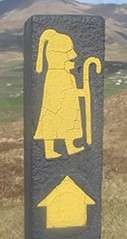Luggala
Luggala (Irish: Log an Lá, meaning "Hollow of the hill"),[lower-alpha 1] also called Fancy Mountain (from Irish Fuinnse, meaning 'ash-tree')[2] at 595 metres (1,952 ft), is the 230th-highest peak in Ireland on the Arderin scale. Being below 600 metres (2,000 ft), it does not rank on the Vandeleur-Lynam or Hewitt scales. Luggala is in the northeastern section of the Wicklow Mountains in Ireland, and overlooks the Lough Tay, which lies at the base of the steep granite cliffs on Luggala's eastern face. As well as a noted scenic point in County Wicklow, Luggala's eastern cliffs have many graded rock-climbing routes.
| Luggala | |
|---|---|
| Fancy Mountain | |
 Luggala behind Lough Tay | |
| Highest point | |
| Elevation | 595 m (1,952 ft) [1] |
| Prominence | 110 m (360 ft) [1] |
| Listing | Arderin |
| Coordinates | 53°06′21″N 6°17′01″W |
| Naming | |
| Native name | Log an Lágh (Irish) |
| English translation | Hollow of the hill |
| Pronunciation | /ˌlʌɡəˈlɑː/ Irish: [ˈl̪ˠɔɡ ə ˈl̪ˠaː] |
| Geography | |
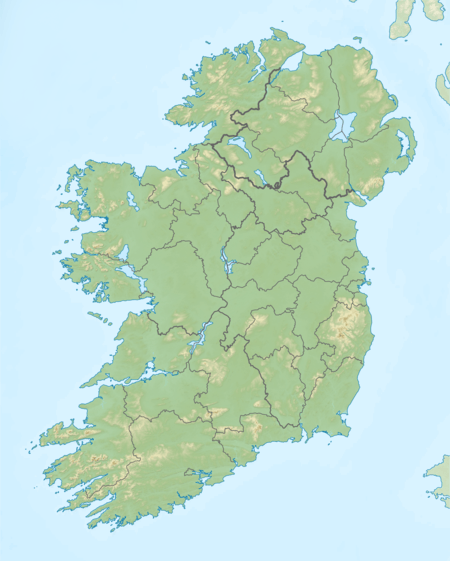 Luggala Location in Ireland | |
| Location | Wicklow, Republic of Ireland |
| Parent range | Wicklow Mountains |
| OSI/OSNI grid | O1501307403 |
| Topo map | OSi Discovery 56[1] |
| Geology | |
| Mountain type | Granite with microcline phenocrysts[1] |
| Climbing | |
| Easiest route | Wicklow Way, from R759 north |

Luggala and Lough Tay are part of the larger 5,000-acre (2,000 ha) privately owned Guinness Estate, which also includes Luggala Lodge. While the estate dates from the 18th-century when it was developed by the La Touche family, it is most associated with its ownership by the Guinness family from 1937 to its sale in 2019. During their ownership, the estate was the location of several films (e.g. Braveheart in 1995), and television series (e.g. Vikings from 2013), as well as visits by notable artists and musicians (e.g. the Beatles and Michael Jackson). A degree of access is granted to the public.
Naming
Historian Liam Price, notes that Luggala, from Irish Log an Lá, meaning 'Hollow of the hill', was also known as Fancy, from Irish: Fuinnse, meaning "ash-tree", and also as Cloghoge (the nearby Cloghoge River drains Lough Tay into Lough Dan).[3] According to Irish academic Paul Tempan, "Price's interpretation of this name [Luggala] as Log an Lágh, or 'hollow of the hill', is doubtful";[2] pointing out that there is no evidence in any Irish language dictionaries for the existence of the term "lágh".[2] He also notes that the other term "Lá" is unlikely to be a translation of "day"; instead, Tempan records the translation as unresolved listing it in Irish Hill and Mountain Names as "hollow of the [obscure element]".[2]
Geography
Luggala is in the northeastern section of the Wicklow Mountains, and directly overlooks Lough Tay, which lies at the base of steep granite cliffs on Luggala's east face; Luggala's other slopes are of a much gentler gradient, and are mostly covered in heather.[4] The mountain is a largely isolated peak, with a deep valley between itself and its only neighbour, the peak of Knocknacloghoge 534 metres (1,752 ft) to the immediate south.[4] Luggala is overlooked from the far north-east by the larger massif of Djouce at 725 metres (2,379 ft).[4][5] Luggala is the 230th-highest peak in Ireland on the Arderin scale,[6] Being below 600 metres (2,000 ft) in height, Luggala does not rank on the Vandeleur-Lynam or Hewitt scales.[7][8]
Luggala Estate
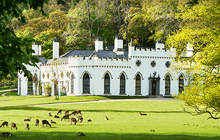
Luggala forms a part of the 5,000-acre (2,000 ha) Luggala Estate (also known as the Guinness Estate after the Guinness family), which was owned by wealthy arts patron Garech Browne, the great-great-great-grandson of Arthur Guinness, until his death in 2018.[9][10] In 2018, the Luggala Estate included the mountains of Luggala and Knocknacloghoge, the entire lake of Lough Tay, and part of the lake of Lough Dan.[11]
The estate was developed by the La Touche family, who founded the Bank of Ireland.[12][13] In 1787, Peter LaTouche built the gothic Luggala Lodge (or "Luggala Castle"), as a hunting lodge which he modelled on Strawberry Hill House in London.[9][12][14] In 1937, Arthur Ernest Guinness purchased the Luggala Estate and then gave it as a wedding gift to his daughter Oonagh on her second marriage, to Lord Oranmore and Browne; she then gifted the property to her son Garech in 1970.[9][10][13] Notable family members buried on the estate include Tara Browne, whose death in a car accident was an inspiration for the Beatles song, A Day in the Life.[15]
By 2018, Luggala Lodge was a 7,437 square feet (690.9 m2), seven-bedroom property, and the entire estate had 16,379 square feet (1,521.7 m2) of residential property.[9][11] The buildings on the estate, including the Lodge, have been rented out commercially, and have included famous guests such as Mick Jagger, the Beatles and latterly, Michael Jackson.[9][16] The estate and grounds have been used as the location of some films, including Zardoz (1974), Excalibur (1981), Braveheart (1995), and King Arthur (2004), as well as the historical drama television series Vikings (from 2013), where it is featured as the fictional village of Kattegat.[9][17]
In 2017, before his death, Browne put the entire estate up for sale with an asking price of 28 million euros.[9][13] In 2006, Browne had sold 1,600 acres (650 ha) of the estate to the Irish state for 1.6 million euros, and it is now part of the Wicklow Mountains National Park.[18] On 27 August 2019, the Irish Times reported that the estate had been sold to an overseas buyer at a "substantial discount" to the asking price.[15] In October 2019, several newspapers reported that the estate had been bought by Italian Count Padulli di Vighignolo and his wife Carolyn Dolgenos, for a sum estimated at 20 million euros.[19][20]
In December 2019, RTÉ aired a documentary titled Last Days at Luggala on Garech Browne's final years on the estate, up until his death in 2018.[21] In January 2020, the entire contents of the estate as owned by Browne, were auctioned at Sotheby's in London.[22]
Access
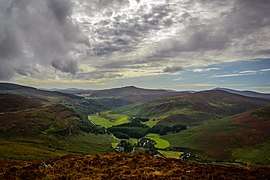
In 2018, the Barbican International Corporation (BIC), a Guinness family Guernsey-based trust who controlled the Luggala Estate, erected new "private property" signage and a notice on a gate just off the R759 road frequently used by the public – called the "Pier gate" – that it would be locked after 5.30 pm.[18]
The BIC trust clarified in a statement that: "There are no public rights of way or rights of access to any of the estate. However, successive owners over recent years permitted public access to certain parts of the estate via the present pedestrian access gate [the Pier gate]".[23]
The action led to protests by hill-walking groups, and calls on the Irish state to purchase the Luggala Estate – which was being offered for sale by the BIC trust for Euro 28 million – and which was bordered on three sides by the Wicklow Mountains National Park.[24][25][26]
In November 2019, it was reported that the new owners of the estate would leave existing public access arrangements in place (e.g. gate open until 5.30 pm).[27]
Recreation
Hillwalking
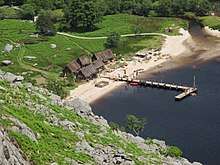
Access permitting, the most common route to the summit of Luggala is from the public access gate on the R759 – known as the "Pier gates" (O173065). This 7-kilometre (4.3 mi), circa 2.5-hour route (to the summit and back), descends a tarmac road down to the bridge of Cloghoge River, where it then leaves the road (that continues on to Lough Dan), to ascend up the 400 metres (1,300 ft) long shoulder to the summit ridge of Luggala; the path is then retraced back to the Pier gates.[28] There is a sandy/gravel mountain path from just beyond the bridge of Cloghoge River, that cuts through the ferns and heathers on Luggala, to the final summit ridge, however, it can be difficult to find in poor weather or low visibility.[29]
A longer 12-kilometre (7.5 mi), circa 5-hour route, incorporates the neighbouring peak of Knocknacloghoge and Lough Dan, before returning to the Pier gates; it is described as "surely one of the most scenic walks in the Wicklow Mountains".[29]
Rock climbing
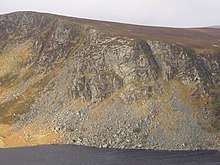
Luggala's east-facing granite cliffs are a rock-climbing location, however, route-finding can be difficult and the conditions are described as a "serious mountain crag".[30] As of July 2019, the online climbing database lists 129 climbs, with the majority in the Very Severe (VS) 4c to E1 5b rock climbing grade categories, however, there are also several extreme routes such as Precious Metal (E7 6c), and The Great Roof (E6 5c, 6c).[30][31]
The Irish Online Climbing Database records five major sections: G & H Buttresses, Woody Wall & Conifer Buttress (Creag Conaisreach), South Buttress (Creag Fasra), Main Face, and North Buttress (Creag Thuaidh).[32] It notes the rock is coarser with better friction than that of Glendalough, however, in contrast to Glendalough, the routes are less direct and do not follow obvious crack-lines; it also notes that the zig-zag nature of routes means that an ability to use double-rope techniques is important to avoid friction drag.[32] Classic climbs are Pine Tree Buttress (S 4a), Muskrat Ramble (HVC 4b, 5a, 4c), and Dance of the Tumblers (E1 5b).[30][32][31]
See also
| Wikimedia Commons has media related to Luggala. |
| Wikimedia Commons has media related to Lough Tay. |
Notes
- Irish academic Paul Tempan disputes whether the translation of "hill" is correct, and instead records the translation as "hollow of the [obscure element]".[2]
References
- "Luggala". MountainViews Online Database. Retrieved 11 July 2019.
- Tempan, Paul (February 2012). "Irish Hill and Mountain Names" (PDF). MountainViews.ie. p. 118. Retrieved 11 April 2020.
- Price, Liam (1946). The Placenames of County Wicklow. Dublin Institute for Advanced Studies. ASIN B001F6OXDS. Retrieved 11 April 2020.
- Dillion, Paddy (1993). The Mountains of Ireland: A Guide to Walking the Summits. Cicerone. ISBN 978-1852841102. Retrieved 14 July 2019.
- Stewart, Simon (2018). "Arderins + Arderin Begs: Irish mountains of 500+m with a prominence of 15+m". MountainViews. Retrieved 14 July 2019.
Listing selection: All summits (531) in list Arderins + Arderin Begs
- Stewart, Simon (October 2018). "Arderins: Irish mountains of 500+m with a prominence of 30m". MountainViews Online Database. Retrieved 14 July 2019.
- Stewart, Simon (October 2018). "Vandeleur-Lynams: Irish mountains of 600+m with a prominence of 15m". MountainViews Online Database. Retrieved 14 July 2019.
- Stewart, Simon (September 2013). A Guide to Ireland's Mountain Summits: The Vandeleur-Lynams & the Arderins. Collins Books. ISBN 978-1-84889-164-7. Retrieved 14 July 2019.
- Lyons, Madeline (25 January 2017). "Guinness ancestral home in Wicklow goes on sale for €28m". Irish Times. Retrieved 22 November 2018.
- O'Byrne, Robert (September 2018). Luggala Days: The story of a Guinness house. CICO Books. ISBN 978-1782496342. Retrieved 14 July 2019.
- "Luggala Estate, Roundwood, County Wicklow, Ireland" (PDF). Sotheby's. Retrieved 14 July 2019.
- "Legacy lives on". Irish Independent. 9 April 2010. Retrieved 12 July 2019.
- Churchill, Penny (9 February 2017). "The Guinness family's incredible estate outside Dublin goes up for sale". Country Life. Retrieved 13 July 2019.
- Bunbury, Turtle. "La Touche of Harristown, Co. Kildare". Retrieved 12 July 2019.
- Mulcahy, Orna (28 August 2019). "Vast Luggala estate in Wicklow sold at discount to overseas buyer". Irish Times. Retrieved 11 April 2020.
- Keenan, Mark (14 March 2014). "€80,000 per month...the real price of disappearing". Irish Independent. Retrieved 14 March 2014.
- Walker, Penny (29 November 2019). "The Irish lough masquerading as a Scandinavian fjord". Daily Telegraph. Retrieved 12 July 2019.
- O'Brien, Tim (1 October 2018). "Closure warning sign at Luggala disappoints hillwalkers". Irish Times. Retrieved 12 July 2019.
- Coyle, Colin (27 October 2019). "Secretive Italian Count Padulli di Vighignolo outed as buyer of cut-price Luggala". Sunday Times. Retrieved 3 November 2019.
- Gleeson, Colin (27 October 2019). "Reclusive Italian count believed to be buyer of Luggala estate". Irish Times. Retrieved 3 November 2019.
- Crawley, Peter (19 December 2019). "Garech Browne: Last Days at Luggala – "We're skirting around the fact he was an alcoholic"". Irish Times. Retrieved 6 April 2020.
- McCárthaigh, Sean (10 January 2020). "Luggala: Contents of Guinness estate go on sale in London". Irish Times. Retrieved 6 April 2020.
- O'Sullivan, Kevin (14 October 2018). "No change to public access at Luggala Estate, say owners". Irish Times. Retrieved 12 July 2019.
- Buchanan, Myles (20 October 2018). "Protest over Luggala access gate". Irish Independent. Retrieved 12 July 2019.
- "Mountaineering Ireland supports petition seeking State purchase of Luggala". Mountaineering Ireland. 18 October 2019. Retrieved 12 July 2019.
- Siggins, Lorna (10 August 2018). "State urged to buy 4,000 acres of Luggala estate for public use". Irish Times. Retrieved 12 July 2019.
- "Update on Luggala Estate". Mountaineering Ireland. 27 November 2019. Retrieved 10 April 2020.
- Guilfoyle, Michael. "Walk for the Weekend: Luggala, Co Wicklow". Irish Times. Retrieved 13 July 2019.
- Fairbairn, Helen (2014). Ireland's Best Walks: A Walking Guide. Collins Press. ISBN 978-1848892118. Retrieved 14 July 2019.
Route 59: Luggala and Knocknacloghoge
- "Luggala". UKClimbing.com. Retrieved 12 July 2019.
Luggala is a serious 'mountain crag'. Most routes are rarely climbed and route finding can be a challenge.
- Flanagan, David (2014). Rock Climbing in Ireland. Three Rock Books. ISBN 978-0956787422. Retrieved 10 April 2020.
- "Luggala". Irish Online Climbing Database. Retrieved 12 July 2019.
Bibliography
Estate
- O'Byrne, Robert (September 2018). Luggala Days: The story of a Guinness house. CICO Books. ISBN 978-1782496342.
Hill walking
- Fairbairn, Helen (2014). Ireland's Best Walks: A Walking Guide. Collins Press. ISBN 978-1848892118.
- Fairbairn, Helen (2014). Dublin & Wicklow: A Walking Guide. Collins Press. ISBN 978-1848892019.
- Stewart, Simon (2013). A Guide to Ireland's Mountain Summits: The Vandeleur-Lynams & the Arderins. Collins Books. ISBN 978-1-84889-164-7.
- Dillion, Paddy (1993). The Mountains of Ireland: A Guide to Walking the Summits. Cicerone. ISBN 978-1852841102.
Rock climbing
- Flanagan, David (2014). Rock Climbing in Ireland. Three Rock Books. ISBN 978-0956787422.
- Mountaineering Ireland (2009). Wicklow Rock Climbing Guide. Mountaineering Ireland. ISBN 978-0902940239.
- Torrans, Calvin; Stelfox, Dawson (1984). Rock Climbing In Ireland. Constable. ISBN 978-0094653207.
External links
- Luggala at Irish Climbing Online
- Luggala Estate, Roundwood, County Wicklow, Ireland, Sotheby's (2018)
- Wicklow Online Rock Climbing Topos, Mountaineering Ireland (updated: 2017)
- MountainViews: The Irish Mountain Website, Luggala (or Fancy)
- Hill Bagging UK & Ireland, the searchable interface for the DoBIH
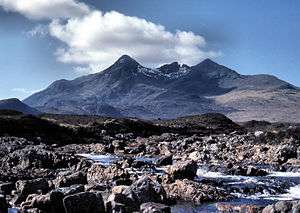
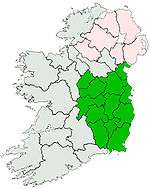
.jpg)
